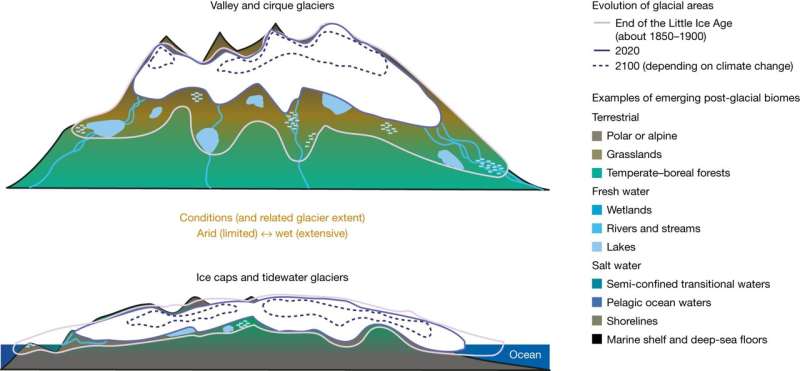August 17, 2023 report
This article has been reviewed according to Science X's editorial process and policies. Editors have highlighted the following attributes while ensuring the content's credibility:
fact-checked
peer-reviewed publication
trusted source
proofread
Modeling the future of glaciers and the new ecosystems that will develop as deglaciation occurs

A team of geologists and geoscientists affiliated with several institutions in Switzerland and two in France, has created a model designed to predict the amount of glacier loss up to the year 2100 and the ecosystems that will arise in their place.
In their paper, published in the journal Nature, the group describes the factors that went into their models. They also argue for the protection of new ecosystems that develop as deglaciation occurs. Nicolas Lecomte with the University of Moncton has published a News & Views piece in the same journal issue, outlining the work done by the team on this new effort.
Prior research has shown that glaciers all across the globe are slowly melting due to global warming. Now, the research team has attempted to estimate the global scope of the problem, while also pointing out that land beneath the glaciers will become new ecosystems and should be protected, if possible.
To create their model, the team used global glacier evolution models that rely on historical expanse data and estimated rises in temperatures to make predictions about future melting amounts for glaciers all over the world—not including those in Antarctica and the Greenland ice sheets.
They aimed to predict how much change could be coming for mountainous and wetland glaciers. They were able to model deglaciation areas which, they note, will become new ecosystems over the years leading up to the turn of the century. In developing their model, they allowed for the different degrees of global warming.
Their model showed that under the worst-case scenario, approximately half of all glacier mass will be gone by 2100. Under the best-case scenario, the model showed loss of approximately 22% of global glacier mass. Under this scenario, the area of loss would still range from the size of Nepal to that of Finland.
The researchers point out that when glaciers melt, they reveal the land beneath—land that may have been covered with ice for thousands of years. Such land, they further note, will naturally evolve into new ecosystems. And because so little research has been conducted regarding the fate of such areas, little is known about their characteristics. They suggest studies of such areas be undertaken, and measures taken if it is found that they need protecting.
More information: J. B. Bosson et al, Future emergence of new ecosystems caused by glacial retreat, Nature (2023). DOI: 10.1038/s41586-023-06302-2
Nicolas Lecomte, The great melt will shape unprotected ecosystems, Nature (2023). DOI: 10.1038/d41586-023-02490-z
Journal information: Nature
© 2023 Science X Network




















